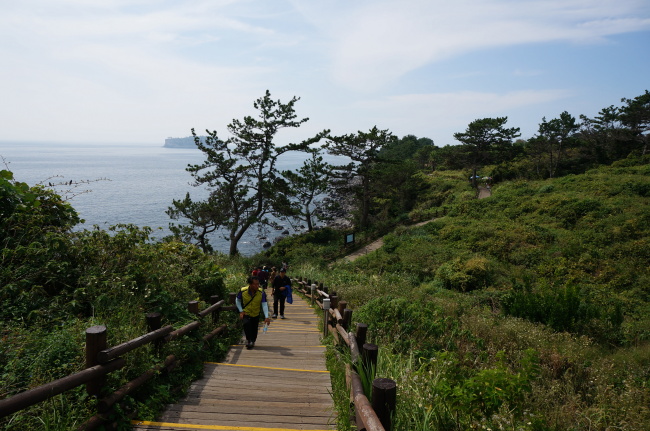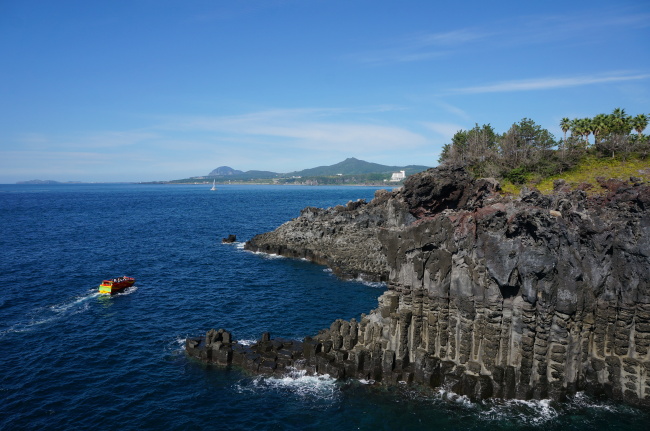
제주 올레길은 한국의 걷기 유행을 일으킨 시초로서 2007년 올레길 조성을 시작으로 전국 지자체들이 너도나도 걷기코스를 조성하게 된 계기이기도 하다. 전직 언론인으로 종사하던 서명숙 현 올레재단 이사장은 2007년 올레길을 디자인하며 제주도의 아름답고 숨겨진 비경을 세상에 공개했다. 현재 21개의 올레길은 제주도의 아름다운 해안선과, 오름, 그리고 마을들을 지나고 있다.
2007년을 시작으로 조성된 현재 까지도 제주도의 올레길은 관리가 매우 잘 되어 있으며 걷기에 편리하다. 그 이유는 제주특별자치도와 올레지기들이 지속적으로 관리하기 때문이다.
많은 올레길 중 7, 8 코스가 관광객들과 걷기 초보자들에게 가장 인기 있는 코스인데 그 이유는 제주도의 다양한 비경의 모습을 볼 수 있기 때문이다.
“7코스는 가장 아기자기하고 풍광이 좋아요. 그리고 아스팔트와 시멘트 길이 제일 적어요. 7코스의 절벽, 벼랑의 풍경들이 정말 아름답죠.” 제주올레 자원봉사팀 7코스 김미선 올레지기가 말했다. 김미선 올레지기는 7코스 시작점에서 아기자기한 카페를 운영중이다.
올레길의 각 코스에는 올레지기가 있는데 이 올레지기들이 길 방향을 안내하는 리본을 메고, 처음 오는 사람들에게 길을 알려주며, 청소까지 담당하고 있다.
7코스의 시작은 외돌개인데 외돌개는 드라마 대장금의 촬영장소로도 유명하다. 외돌개를 바라보는 곳에는 촬영현장을 알리는 주인공이었던 배우 이영애의 사진이 걸려있다. 외돌개를 지나 조성이 잘 된 나무길을 걷다 보면 돔베낭길이라는 길을 만나게 되는데 이 길에서 방문객들은 제주도의 특이한 자연을 만날 수 있다. 이 돌 해변가에는 화산활동의 증거인 특이한 절벽과 돌을 볼 수 있다.
7코스의 때묻지 않은 원시적인 자연의 모습은 강정마을에서 다른 모습을 띄기 시작한다. 아름다운 바다마을은 현재 해군기지 건설 반대 현장으로 변했다. 오래 지속되고 있는 이 싸움은 작년 정치계의 주요 이슈로 떠올랐으며 여전히 지속되고 있다. 해군기지 건설 현장에서 완성이 되어가는 모습이 보이고 있지만, 마을 곳곳에는 여전히 종교단체, 진보단체 등과 주민들이 시위하고 있는 모습을 볼 수 있고, 주민들 집 앞 문에는 해군기지 건설 반대의 표시인 노란색 깃발이 걸려져 있는 모습을 볼 수 있다.
제주도에서 제주의 풍광을 사진찍고 있는 강충세 사진가는 이러한 모습들이 제주민들의 폐쇄적인 면과 관련이 있다고 설명한다.
“제주도 사람들이 육지 사람들을 부를 때 쓰는 속어 (육지껏) 이라고 부르는 데서부터 알 수 있어요. 강정마을 해병기지 건설에도 일단 먼저 반대하고 보지요. 제주 4.3 사건으로 인해 제주사람들이 육지사람을 경계하게 된 것은 이해할 만 합니다.” 라고 그는 설명했다.

8코스는 제주 올레길에서 가장 긴 코스 중의 하나로 그 길이가 19.2 킬로미터가 된다. 그러나 중문관광단지 내에 위치하고 있어 가장 접근이 쉬운 코스이기도 하다. 실제 하얏트 리젠시 제주와 신라호텔의 산책길이 8코스의 일부분이다.
8코스를 걷다 보면 거친 제주도의 현무암 해변이 시야에 들어온다. 그 중 가장 아름다운 풍광은 주상절리에서 볼 수 있는데 용암이 굳으면서 만든 세로 돌 기둥이나 6각형 모양의 돌이 장관이다.
주상절리 입구에는 제주도의 다양한 풍광들을 찍은 사진을 파는 사진가가 있는데 제주도의 다양하고 아름다운 모습을 감상하고 싶다면 들를 것을 추천한다. 고승찬 사진가는 본인이 직접 촬영한 제주도의 다양한 풍광들을 사진과 그 보다 작은 사이즈인 엽서로 판매하고 있다. 고작가에 따르면 한라산 꼭대기에 눈이 쌓인 모습이 보이고, 노란 유채꽃이 아래에 피어있는 모습이 보이고, 게다가 맑은 하늘이 있는 풍경은 몇 년에 한번 올까 말까인 희귀한 풍경이라고 한다.
하얏트 리젠시 제주에서 논짓물까지 이어지는 길은 험하기로 소문난 해병대길이다. 해병대 병사들이 일반인들이 걸을 수 있도록 만들어 놓은 2킬로미터 정도의 돌 해변 길은 몇 년 전 태풍으로 길이 망가진 후 폐쇄가 되었다. 이 길을 대신해서 예래 생태마을쪽으로 도는 6.3 킬로미터의 길이 새로 생겼다.
8코스 끝 쪽으로 오면 논짓물이라는 것을 만날 수 있는 데 여긴 바닷물이 아닌 민물로 된 수영장이 해변가 바로 위에 위치해 있다. 여긴 빗물이 고여서 지하수로 나오는 장소인데 제주도에는 빗물이 저장되서 지표면으로 분출되는 용천수가 나오는 장소가 몇 군데 된다고 한다.
“여름에 올레길 걷다가 여기서 목욕하면 엄청 시원해요.” 라고 강충세 사진가는 말한다.
제주 올레길 7,8 코스는 공항 리무진 버스 600번을 타고 갈 수 있다. 식당과 슈퍼마켓, 화장실은 걷는 길 중간 중간에 볼 수 있다. (한글 번역 이우영 기자)
사진: 제주도의 다양한 풍광들을 감상할 수 있는 올레길 7, 8 코스 (코리아헤럴드 이우영 기자)
Walk along the coast to discover Jeju’s beauty
By Lee Woo-young
Jeju Olle trail is the first walking trail in Korea, developed and built by journalist-turned-walking enthusiast Seo Myeong-suk. The opening of the first trail in 2007 trigged a nationwide walking boom, inspiring other provinces to create their own trails, even borrowing the name “Olle,” a word in the local Jeju dialect meaning a narrow alley leading from a house to a main street.
Since Seo Myeong-suk started designing and developing some of the beautiful, hidden trails on Jejudo Island in 2007, Jeju Olle now has a total of 21 trails that follow the island’s beautiful coastline, going up and down small volcanic hills and taking hikers through local villages.
The trails are well built, clean and easy to walk as they are under constant care by the Jeju government and trail caretakers.
Of the many trails, courses 7 and 8 are among the trails most frequently visited by tourists and novice walkers. They are well-known for having diverse features of the beautiful Jejudo Island landscape that range from towering cliffs, rocky shores and sandy beaches to small ports and local residents’ front doors.
“Course 7 has the reputation of being the prettiest path of the Olle trails. It is the trail least paved with asphalt or cement. The scenes looking on the cliffs are just breathtaking,” said Kim Mi-sun, voluntary caretaker of trail 7 who runs a small café at the start of the trail.
Each course has a caretaker, who maintains the trail by making sure ribbons indicating directions are tied, assisting visitors with directions and cleaning. The ribbons and signs prevent walkers from getting lost along the course.
Course 7 starts at a narrow seaside trail that overlooks Oedolgae Rock. The site attracts hundreds of tourists as it was featured in the popular 2003 TV series “Daejangguem.” A big picture of actress Lee Young-ae, who played the main role in the drama, is placed on the trail, serving as a photo spot for tourists.
Following the well-maintained wooden trail, one faces a challenging walk called “dombaenang-gil” along the rocky shoreline that features Jejudo Island’s unique formations of volcanic basalt rocks.
Course 7’s pristine nature starts to give way to signs of human activity in Gangjeong. The once-small scenic village has now turned into the stage for demonstrations against the construction of a new naval base there.
The long-standing dispute, which emerged as a hot political issue last year, has not receded yet as religious groups, progressive political parties and NGO activists still hold sit-ins near the construction site.
Although the naval base is nearing partial completion, yellow flags, a sign of protest, hang on houses in the village.
Kang Chung-sea, a photographer who has been capturing scenes of Jeju Olle walking trail, explained that the protest has to do with the Jejudo Island natives’ insular character that resists outside influence.
“You can guess from the slang they use for talking about people from the mainland with a lowly and inferior connotation. By nature, they oppose the forces coming from the mainland, including the central Korean government’s decision to build the naval base,” said Kang.
The people of Jeju may still harbor the psychological trauma of watching their neighbors and family members being killed in the April 3, 1948, massacre, which sought to suppress an uprising by Jeju-based progressive activists against the central government.
Course 8 is one of the longest courses on Jeju Olle trail, stretching 19.2 kilometers along the southern coast. But it’s an easily accessible route because it goes through the Jungmun Tourism Complex, a cluster of popular hotels and resorts. The course shares some parts of its path with the hotel promenades at Hyatt Regency Jeju and The Shilla Jeju.
Course 8 offers a stretch of rough, rocky beaches, offering the most pristine sea view of Jejudo Island. The best sea view can be seen at Jusangjeoli cliff, one of the most famous tourist sites. The cliff has a unique volcanic rock formation with rock pillars shaped like cubes or hexagons.
To get a glimpse of the diverse Jeju landscapes, a stop at the photo stand at the entrance of Jusangjeoli cliff, run by local photographer Koh Seung-chan, is recommended. He displays and sells his breathtakingly impressive works in prints and postcards featuring Jeju’s diverse landscape.
According to Koh, some pictures like Hallasan Mountain with snow on the peak and yellow canola flowers in a field under a clear blue sky were moments that come only once every few years.
The path called “The Marine Corps Trail” from Hyatt Regency Jeju to Nonjitmul is notorious as one is required to hike the rocky 2-km shore. But the trail is currently closed after a severe typhoon a couple years ago destroyed the path built by the Marine Corps.
It has been substituted by a 6.3-km trail that circles the eco-village Yerae-dong.
Course 8 includes a natural spring swimming pool, which is one of the unique geological features of the island, at Nonjitmul. The freshwater swimming pool, located just above the seashore, is a result of the spring water rising to the ground surface from rainfall.
“It’s really nice to take a dip while walking on the Olle trail in summer,” said Kang.
Jeju Olle walking trail courses 7 and 8 can be reached by airport limousine bus 600 from Jeju International Airport. Restaurants, small supermarkets and restrooms are seen along the streets.
(wylee@heraldcorp.com)








![[Kim Seong-kon] Democracy and the future of South Korea](http://res.heraldm.com/phpwas/restmb_idxmake.php?idx=644&simg=/content/image/2024/04/16/20240416050802_0.jpg&u=)







![[KH Explains] Hyundai's full hybrid edge to pay off amid slow transition to pure EVs](http://res.heraldm.com/phpwas/restmb_idxmake.php?idx=652&simg=/content/image/2024/04/18/20240418050645_0.jpg&u=20240418181020)

![[Today’s K-pop] Zico drops snippet of collaboration with Jennie](http://res.heraldm.com/phpwas/restmb_idxmake.php?idx=642&simg=/content/image/2024/04/18/20240418050702_0.jpg&u=)